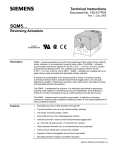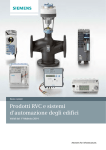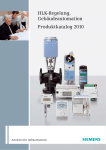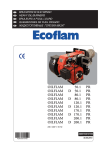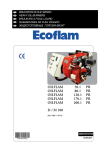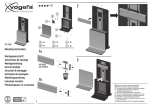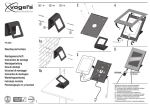Download Siemens SQM5 Automobile Parts User Manual
Transcript
Technical Instructions
Document No. 155-517P25
July 9, 2007
SQM5…
Reversing Actuators
EA0511R1
ISO 9000 and 14000
REGISTERED FIRM
¤
Description
SQM5... reversing actuators are used for the positioning of flow control valves, butterfly
valves, dampers, or any application requiring rotary motion. The SQM5… actuators
accommodate control input signals of 4 to 20 mA, 0 to 135 Ω, 0 to 10 Vdc, 0 to 20 mA,
position proportional and floating control. The available output signals include
4 to 20 mA, 0 to 135 Ω, 0 to 10 Vdc, 0 to 20 mA, and 0 to 1000 Ω. SQM5… actuators
are available with up to six internal, easily adjustable switches.
A selection of exchangeable circuit boards provide a variety of functions including
auto/manual selector switch, manual forward/reverse toggle switch, zero and span
adjustment, parallel or master/slave operation, split range control, input signal override,
and selectable electronic linearization.
The SQM5… is engineered for precision. It is particularly well suited for applications
requiring a high degree of modulating accuracy and repeatability. Drive shaft play is
limited to 0.3° with a modulating accuracy of 250 repositions through 90° of travel.
The SQM5… actuator may be mounted in any position. A selection of mounting
brackets and shafts provides installation flexibility and allows for the simple
replacement of most competitive actuators.
Features
•
Modulating accuracy of 250 repositions through 90°
•
Two limit switches, plus up to four internal auxiliary switches
•
Fully closed “economy position” switch
•
Drive shaft and cam drum disengagement clutches
•
Auto/manual switch, manual control forward/reverse toggle switch
•
UL, CSA approved 24 and 110 Vac versions
•
CE approved 220 Vac versions
•
Field reversible clockwise (cw) or counterclockwise (ccw) operation
•
Various torque ratings and running times available
•
Selection of field exchangeable single-ended and dual-ended shafts
•
Mounting brackets to replace competitive actuators
Siemens Building Technologies, Inc.
Technical Instructions
Document No. 155-517P25
July 9, 2007
Features, Continued
Application
SQM5… Reversing Actuators
•
Connections for both base and face mounting
•
Low hysteresis actuator and potentiometer gearing
•
Externally visible position indication
•
Selection of input and output signals
•
Zero and span adjustment
•
Field exchangeable circuit boards and potentiometers
•
Electronic damper linearization function
•
Split range and selectable parallel or master/slave operation
•
Adjustable input signal override function
SQM5… actuators are uniquely suited for both industrial and commercial
applications. The high level of accuracy permits precise modulating control of
industrial process and process heating applications, often significantly enhancing
performance and product quality.
In commercial and industrial burner applications requiring high turndown and
reliable ignition, the auxiliary switches can be applied to create separate positions
for burner ignition and low fire. In dual fuel applications, additional switches can be
used to create separate high fire, low fire and ignition positions for each fuel. The
economy position switch is used to drive the actuator to the full closed position
when the burner is off.
In all applications, commissioning is simplified. Shaft and cam drum disengagement
clutches allow for the quick manual alignment of the actuator shaft and switch
cams. The forward/reverse toggle switch in combination with the auto/manual
selector switch provides direct manual control.
Page 2
Siemens Building Technologies, Inc.
SQM5… Reversing Actuators
Table Of Contents
Technical Instructions
Document No. 155-517P25
July 9, 2007
Application
Product Numbers
Product numbers for pre-assembled UL/CSA/CE-approved
actuators, Table 1
Product numbers for accessories, Table 2
SQM5… Product Number Identification Legend
Installation and Operating Instructions
Shaft Installation
Rotational Direction Verification
Actuator Mounting
Switch Adjustment
Shaft Adjustment
Cam Drum Adjustment
Wiring
Electrical Connection
Grounding
Wiring Connections
AGA56.1… circuit boards
AGA56.41/42/43… circuit boards
AGA56.9… circuit boards
Commissioning
Modulation Adjustment
Zero Adjustment
Span Adjustment
Cover Installation
Features
SQM5x.xxxxxZx actuators
SQM5x.xxxxxGx actuators
SQM5x.xxxxxHx actuators
SQM5x.xxxxxKx actuators
SQM5x.xxxxxAx actuators
Service Guide
Reversing Rotational Direction
Shaft Installation
Circuit Board Installation
AGA56.41/42/43…
AGA56.9A
AGA56.1A97
Potentiometer Removal/Installation
Specification Data
Dimensions
Siemens Building Technologies, Inc.
Page 2
Page 4
Page 5
Page 6
Page 7
Page 8
Page 8
Page 8
Page 9
Page 9
Page 9
Page 9
Page 10
Page 11
Page 13
Page 15
Page 15
Page 15
Page 16
Page 16
Page 18
Page 18
Page 18
Page 18
Page 18
Page 20
Page 20
Page 20
Page 22
Page 24
Page 25
Page 26
Page 29
Page 3
Technical Instructions
Document No. 155-517P25
July 9, 2007
SQM5… Reversing Actuators
Table 1. Product Numbers for Pre-assembled Actuators.
90
90
90
90
90
90
90
140
140
140
140
140
140
140
140
140
140
140
140
140
140
140
140
140
140
140
140
140
140
200
200
200
200
200
200
200
200
200
310
310
310
310
310
400
400
400
400
400
400
1.
2.
3.
Page 4
x
x
x
x
x
x
x
x
x
x
x
x
x
x
x
x
x
x
x
x
x
x
x
x
x
x
x
x
x
x
x
x
x
x
x
x
x
x
x
x
x
x
x
x
x
x
x
x
x
x
x
Product Number
0-10 Vdc
ccw
cw
ccw
cw
ccw
cw
ccw
ccw
cw
ccw
ccw
cw
ccw
ccw
ccw
cw
ccw
ccw
ccw
ccw
cw
ccw
cw
ccw
cw
ccw
cw
ccw
ccw
ccw
ccw
ccw
ccw
cw
ccw
ccw
cw
ccw
ccw
ccw
ccw
ccw
ccw
ccw
ccw
cw
ccw
cw
ccw
0-135 Ω
8
8
8
8
8
8
8
12
12
12
12
12
25
25
25
25
25
25
25
25
25
25
25
25
25
25
25
25
25
25
25
25
25
25
25
25
25
25
37
37
37
37
37
50
50
50
50
50
50
Input Control Signals3
4-20 mA
[lb-in]
Running
Time 2
90°@ 60
Hzsec
Line
Voltage
Torque1
Rotation
direction
Product Numbers
x
x
x
x
x
x
x
x
x
x
x
x
x
x
x
x
x
x
x
x
x
x
x
x
x
x
x
x
x
x
x
x
x
x
x
x
110 V
SQM50.261R1G3
SQM50.261R1G3R
SQM50.264R1A
SQM50.264R1A0R
SQM50.264R1A3
SQM50.264R1G3R
SQM50.264R1G4
SQM50.361R1G3
SQM50.361R1G3R
SQM50.361R1G7
SQM50.364R1G3
SQM50.364R1G3R
SQM50.461R1A
SQM50.461R1A3
SQM50.461R1G3
SQM50.461R1G3R
SQM50.461R1H3
SQM50.461R1Z3
SQM50.461R1Z7
SQM50.464R1A
SQM50.464R1A0R
SQM50.464R1A3
SQM50.464R1A3R
SQM50.464R1G3
SQM50.464R1G3R
SQM50.464R1G7
SQM50.464R1G7R
SQM50.464R1H3
SQM50.464R1Z3
SQM53.464R1A
SQM53.464R1A3
SQM53.464R1G3
SQM53.464R1G7
SQM53.464R1G7R
SQM53.464R1Z3
SQM53.467R1Z3
SQM53.467R1Z3R
220 V
24 V
SQM50.264R2A
SQM50.464R8A
SQM50.464R8G3
SQM50.464R2G3R
SQM50.464R2Z3
SQM50.464R8H3
SQM50.464R8Z3
SQM53.464R2Z3
SQM53.467R2A3
x
x
x
x
x
x
x
x
x
x
x
x
x
x
x
SQM56.564R1A
SQM56.564R1G4
SQM56.564R1G7
SQM56.564R1H4
SQM56.564R1Z3
SQM56.664R1G3
SQM56.664R1Z3
SQM56.667R1A3R
SQM56.667R1G3
SQM56.667R1G7R
SQM56.667R1Z3
Torque will vary with the selection of the shaft. See Specifications.
Running time for 135° Æ multiply by 1.5. For 50 Hz Æ multiply by 1.2
SQM5x.xxxxxZx models also accept a 0 to 20 mA input signal.
Siemens Building Technologies, Inc.
SQM5… Reversing Actuators
Technical Instructions
Document No. 155-517P25
July 9, 2007
Table 2. Product Numbers for Accessories.
Electronic Circuit Boards
AGA56.1A97
AGA56.9A87
AGA56.9A17
AGA56.9A27
AGA56.41A87
AGA56.41A17
AGA56.41A27
AGA56.42A87
AGA56.42A17
AGA56.42A27
AGA56.43A87
AGA56.43A17
AGA56.43A27
24-250 Vac
24 Vac
110 Vac
220 Vac
24 Vac
110 Vac
220 Vac
24 Vac
110 Vac
220 Vac
24 Vac
110 Vac
220 Vac
Shafts
(A) board for SQM5x.xxxxxAx
(Z) board for SQM5x.xxxxxZx
(Z) board for SQM5x.xxxxxZx
(Z) board for SQM5x.xxxxxZx
(G) board for SQM5x.xxxxxGx
(G) board for SQM5x.xxxxxGx
(G) board for SQM5x.xxxxxGx
(H) board for SQM5x.xxxxxHx
(H) board for SQM5x.xxxxxHx
(H) board for SQM5x.xxxxxHx
(K) board for SQM5x.xxxxxKx
(K) board for SQM5x.xxxxxKx
(K) board for SQM5x.xxxxxKx
See Product Number Identification Legend, Figure 1.
Mounting Brackets & Adapters
AGA57.3 for replacement of Honeywell MOD III, IV
actuators
AGA57.4 for replacement of Honeywell M640/740/940 and
Barber Colman EA20/40/50/60 actuators. Directly
adaptable to Eclipse butterfly valves.
ASK33.9 mounting kit for direct attachment to Siemens
VKF41... butterfly valve. (Shaft AGA58.1
required)
AGA58.1 10 mm round with key. Gear end only.
AGA58.2 12 mm round with key. Gear end only.
AGA58.3 9 mm square. Dual-ended.
AGA58.4 3/8 inch square. Dual-ended.
AGA58.7 14 mm round with key. Gear end only.
For exact shaft sizes, see Dimensions.
Crank Arm, Push Rods
338 031 Crank arm kit. Includes two crank arms for
connecting the AGA58.4 shaft to a ∅ 1/2-inch
damper shaft with two ball joints. (Does not include
push rod.)
338 041
338 042
338 043
338 044
338 045
338 046
∅ 5/16" damper push rod, 12 inches long.
∅ 5/16" damper push rod, 15 inches long.
∅ 5/16" damper push rod, 18 inches long.
∅ 5/16" damper push rod, 24 inches long.
∅ 5/16" damper push rod, 36 inches long.
∅ 5/16" damper push rod, 48 inches long.
Potentiometers
ASZ12.803 and ASZ12.30 1000Ω, 90°
ASZ12.833 and ASZ12.33 1000Ω, 135°
ASZ22.803 and ASZ22.30 1000/1000Ω double
potentiometer, 90°
ASZ22.833 and ASZ22.33 1000/1000Ω double
potentiometer, 135°
ASZ16.703 135Ω, 90° (wire wound)
ASZ16.733 135Ω, 135° (wire wound)
ASZ66.733 135Ω/135Ω, double potentiometer 135°
(wire wound)
Additional potentiometer models available. See
Siemens technical data sheet 7921.
Siemens Building Technologies, Inc.
Page 5
Technical Instructions
Document No. 155-517P25
July 9, 2007
SQM5… Reversing Actuators
Product Number Identification Legend
For actuator identification only. To select product numbers for ordering, see Table 1.
Figure 1. SQM5… Product Number Identification Legend.
SQM5 0 . 4
8
0
R
1
Z
3
R
Actuator family
Torque
0
0
3
6
6
in-lb @ 60 (50) Hz.
90 for 8 (10) sec. running time
140 for 12 (15), 25 (30), 37 (45) sec.
200 for 25 (30) sec.
310 for 37 (45) sec.
400 for 50 (60), 75 (90)sec.
Running time for 90°
Not all actuator running times are
available in each torque.
Refer to table 1
60 Hz.
50 Hz.
8 sec.
2
2 10 sec.
12 sec.
3
3 15 sec.
25 sec.
4
4 30 sec.
37 sec.
5
5 45 sec.
50 sec.
6
6 60 sec.
Number of SPDT switches
6 2 limit and 4 auxiliary switches
Shaft selection
0 no shaft (shaft must be ordered separately)
1 round 10 mm, single ended (for use with VKF41... butterfly valves)
4 square 3/8 inch, dual ended
7 round 14 mm, single ended
Approvals
R UL recognized, CSA certified
Operating voltage (Vac @50-60 Hz)
1 110-120 Vac
2 220-240 Vac
8 24 Vac
Internal circuit board (SQM5x.xxxxx G, H, K , Zx actuators require potentiometer ASZ…)
A AGA56.1A97 (position proportional control)
G AGA56.41A... (4 to 20 mA input)
H AGA56.42A... (0 to 135 Ohm input)
K AGA56.43A... (0 to 10 Vdc input)
Z AGA56.9... (all inputs/outputs, linearization, split ranging, override and pre-set positioning)
Potentiometer (1000 Ohm required when using SQM5x.xxxxx G, H, K, Zx actuators)
3 ASZ12.30 (1000 ohm, 90°)
4 ASZ12.33 (1000 Ohm, 135°)
7 ASZ22.30 (1000/1000 Ohm, 90°)
8 ASZ22.33 (1000/1000 Ohm, 135°)
B ASZ16.703 (135 Ohm, 90°)
C ASZ16.733 (135 Ohm, 135°)
L ASZ66.733 (135/135 Ohm, 135°)
(Product numbers ending without R are ccw)
Rotational Direction
R Clockwise (when facing gear end. See Figure 6 .)
Page 6
Siemens Building Technologies, Inc.
SQM5… Reversing Actuators
Installation and
Operation
Instructions
Technical Instructions
Document No. 155-517P25
July 9, 2007
SQM5… actuators are sometimes shipped without the shaft installed. To install the
selected shaft:
1. Loosen the two screws on the actuator cover corners. See Figure 2.
2. Lift the screws and raise the cover. See Figure 3.
EA0564R1
EA0568R1
Shaft Installation
Figure 3.
Figure 2.
3. Each shaft is supplied with two washers and a “C” clip. See Figure 4. Using
spreading pliers, remove the “C” clip and the washers from the shaft.
KEY END
INSERT END
SHAFT KEY
EA0559R1
WASHERS ON
BOTH SIDES
OF THE BEARING
C-CLIP
Figure 4.
4. Insert the “insert end” of the shaft into the “gear end” of the actuator.
5. Push the shaft until the “insert end” reaches just short of the brass bushing at the
other end of the actuator.
6. Put one of the washers on the insert end of the shaft. See Figure 5.
EA0569R1
WASHERS
Figure 5.
7. Line up the “shaft key” with the key slot on the “gear end” of the actuator and slide
the shaft until the “insert end” is completely through the brass bushing.
8. Place the second washer onto the “insert end” of the shaft. Using spreading pliers,
install the “C” clip.
Siemens Building Technologies, Inc.
Page 7
Technical Instructions
Document No. 155-517P25
July 9, 2007
SQM5… Reversing Actuators
Actuator model numbers that end with “R” are factory configured for clockwise (cw),
minimum to maximum rotation when facing the gear end of the actuator, or
counterclockwise (ccw) rotation when facing the other end of the actuator. The gear end
of the actuator is the side opposite of the visual position indicator.
Rotational Direction
Verification
To field reverse the direction of rotation, see Service Guide, “Reversing Rotational
Direction”.
Actuator Mounting
SQM5… actuators can be mounted in any orientation using the four 1/4"-20 UNC
tapped holes located on the bottom corners of the actuator base. Optional base
mounting brackets are available. See Table 2.
SQM5… actuators can also be face mounted using self tapping screws in combination
with the various holes on the face of the actuator gear end.
ACTUATOR
POSITION SCALE
SWITCH CAM I
SET AT MAXIMUM
ACTUATOR POSITION
INDICATING POINTER
CAM DRUM
RELEASE BUTTON
DIAL POINTER
SWITCH CAM II
SET AT ZERO ("ECONOMY") CAM DRUM
ASZ... (1000 Ohm)
FEEDBACK POTENTIOMETER
SWITCH CAM III
SET AT MINIMUM
50
50
50
30
30
30
30
10
10
50
0
0
0
10
0
10
0
10
0
70
ACTUATOR POSITION
INDICATING DIAL
0
SINGLE SWITCH
CAM POINTER
GEAR END
EA0561R3
DOUBLE SWITCH CAM POINTER
Figure 6. Component Identification on the Cam Drum Side of the SQM5… Actuator.
Switch Adjustment
See Figure 6.
All SQM5…actuators are factory wired with Switch I (maximum), Switch II (fully closed
“economy position”) and Switch III (minimum). The individual switch cams I, II, and III
are factory set to 90°, 0° and 10° respectively.
NOTE:
The single switch cam pointers are used together with the black scales when
configured for counterclockwise (ccw) operation.
The double switch cam pointers are used together with the red scales when
configured for clockwise (cw) operation.
The individual switch cams can be adjusted by hand or with the use of the tool
attached to the outside of the hinged switch terminal protection lid.
Page 8
Siemens Building Technologies, Inc.
SQM5… Reversing Actuators
Technical Instructions
Document No. 155-517P25
July 9, 2007
Switch Adjustment,
Continued
NOTE:
Shaft Adjustment
The actuator shaft can be disengaged by pressing the silver shaft release button. The
button is located above the grounding screw, under the hinged terminal protection
cover, and to the right of the auto/manual switch. After pressing the shaft release button
in and slightly upward, the shaft can be manually rotated. After the shaft has been
manually aligned to the closed position, re-engage the shaft by pushing the shaft
release button downwards.
See Figure 6.
Cam Drum Adjustment
See Figure 6.
Position Indicating Dial
Adjustment
If a potentiometer is installed, the adjustable range of the switches depends
on the range of the potentiometer.
SQM5x.xxxxxAx actuators may be adjusted between 0° and 160°.
SQM5x.xxxxxx3 actuators have a 90° potentiometer and the switches must be
adjusted only between 0 and 90°.
SQM5x.xxxxxx4 actuators have a 135° potentiometer and the switches must
be adjusted only between 0 and 135°.
Once the shaft has been set, the cam drum must be manually aligned by pressing and
holding the black cam drum release button (see Figure 6). Rotate the cam drum until
the “0” mark on the actuator position scale (left scale on the cam drum) is aligned with
the gray actuator position indicating pointer.
The actual position of the SQM5… actuator is indicated by the gray actuator position
indicating pointer (see Figure 6). The position is also displayed by the indicating dial
through the housing’s window. Ensure that the actuator position indicating dial is
aligned with the actuator position scale. If necessary, rotate the dial in the clockwise
direction.
CAUTION:
Turning the dial in the counterclockwise direction may loosen the
potentiometer locking screw.
Wiring
Electrical Connection
SQM5… actuators are equipped with two removable conduit connection plates located
on the upper corner of the gear housing. Each plate is provided with two threaded
connections for 1/2" NPSM conduit connectors. The use of flexible stranded wire is
recommended.
Grounding
CAUTION:
To avoid electro-magnetic interference, the SQM5… actuators must be
grounded.
The ground terminal is located to the right of the auto/manual switch.
Disconnect the circuit board wire marked 51 during high voltage testing.
Reconnect it to the grounding terminal after the test.
Siemens Building Technologies, Inc.
Page 9
Technical Instructions
Document No. 155-517P25
July 9, 2007
Wiring Connections
SQM5… Reversing Actuators
NOTE:
SQM5… actuators require a single source, single phase power supply.
Wiring connections vary depending on which AGA56…. circuit board is installed.
AGA56.1… circuit boards. Manual Operation
See Figures 7 and 8.
1. Set the AUTO/MAN switch in the MAN position.
2.
Connect ground to the screw located below the shaft release button.
3.
Connect neutral to the double terminal block, located on the left side of the gray
switch housing.
4.
Only terminal "L" must be to enable manual operation. The actuator can now be
driven to the maximum position (switch cam I) or the fully closed "economy
position" (switch cam II) by using the toggle switch located to the left of the
AUTO/MAN switch.
Automatic Operation
1. Set the AUTO/MAN switch in the AUTO position.
2. Connect ground to the screw located below the shaft release button.
3. Connect neutral to the double terminal block located on the left side of the gray
switch housing.
4. Connect line voltage to terminal A to drive the actuator in the opening direction.
5. Connect line voltage to terminal Z to drive the actuator in the closing direction.
CAUTION:
Do not power terminals A and Z simultaneously. Actuator damage will occur.
A
L
Z
AGA56.1A97
51
MAN
shown in
auto position
1
actuator switch
I Maximum/High fire
II "Economy"/Fully closed
III Minimum/Low fire
IV...VI Auxilliary
AUTO
2
13
EA0555R3
N
M
I
11
1
II
12
21
2
22
4
3
13
23
14
5
V
IV
III
24
15
6
VI
25
16
c
b
ASZ...
(1000 Ohm)
26
21 12
a
wire leads
Figure 7. Basic Functional Diagram of AGA56.1…
Page 10
Siemens Building Technologies, Inc.
SQM5… Reversing Actuators
Technical Instructions
Document No. 155-517P25
July 9, 2007
Wiring, Continued
A
Z
L
A
Z
L
MAN.
0
EA0554R3
AUTO.
AGA56.1A97
Figure 8. AGA56.1A97 Terminal/Auto-Manual Board.
AGA56.41/42/43…
Circuit Boards.
Manual Operation
See Figures 9 and 10.
2. Connect ground to the screw located below the shaft release button.
1. Set the AUTO/MAN switch in the MAN position.
3. Connect neutral to terminal N.
4. Only terminal "L" must be powered to enable manual operation. The actuator can
now be driven to the maximum (high fire) position (switch cam I) or the fully closed
"economy position" (switch cam II) by using the toggle switch located to the left of
the AUTO/MAN switch.
Automatic Operation
1.
Set the AUTO/MAN switch in the AUTO position.
2.
Connect ground to the screw located below the shaft release button.
3.
Connect neutral to terminal N.
4.
Connect line voltage at all times to terminal L to provide power to the electronic
circuit board.
5.
Connect line voltage to terminal LR to provide power when modulating. Connect
line voltage to Terminal LR only after removing power on terminals A and Z
(otherwise actuator damage may result).
6.
Connect line voltage to terminal A to drive the actuator to the maximum (high fire
purge) position.
Once the maximum position is reached, terminal 11 (on switch I) will be energized
to provide position feedback.
7.
Connect power to terminal ZL to drive the actuator to the minimum (low-fire)
position. Once the minimum position is reached, terminal 23 (on switch III) will be
energized to provide position feedback. Adjustment of switch III will determine the
low-fire stop position. Switch III (low fire) must be set at a higher position than
switch II (fully closed). Terminal ZL may be energized only after removing power
from terminals A, Z, 13, and LR.
8.
Connect line voltage to terminal Z to drive the actuator to the fully closed/economy
position (switch II).
9.
Connect the input control signal wires to the appropriate terminals. See Figure 9.
CAUTION:
Do not power terminals A and Z simultaneously. Actuator damage will
occur.
Siemens Building Technologies, Inc.
Page 11
Technical Instructions
Document No. 155-517P25
July 9, 2007
SQM5… Reversing Actuators
Wiring, Continued
A
N
L
13
Z
LR
ZL
AGA56.4...
Y+
AGA56.41...
("G" board 4...20 mA)
Y-
REG
MAX
U
B
M
W
Y
R
(+2 V)
135 Ohm
OPE
MAX
MIN
AGA56.42...
("H" board
0-135 Ohm)
0...2 V
MIN
MIN
Y
MAX
M
AGA56.43...
("K" board 0...10 V)
51
Y
MIN MAX
2
1
13
3
2
I
blue
1
IV
III
c
6
5
4
3
II
black
N
actuator switch
I Maximum/High fire
II "Economy"/Fully closed
III Minimum/Low fire
IV...VI Auxilliary
for ccw
rotation
shown in
auto position
AUTO
brown
MAN
VI
V
EA0556R5
ASZ...
(1000 Ohm)
b
M
11
12
21
22
13
14
23
24
15
25
16
26
21 12
a
wire leads
Figure 9. Basic Functional Diagram of AGA56.4…
OPE MAX MIN
Y-
Y+
ZL
N
13
LR
A
Z
Y
OPE MAX MIN
L
MAX
MAX
MIN
MIN
M
U
ZL
N
13
LR
MAN.
AUTO.
EA0552R4
EA0553R4
L
0
AUTO.
"G" Board
Z
MAN.
0
AGA56.41A...
A
4 to 20mA
OPE MAX MIN
Y
MM
Y
3
L
ZL
Pos
N
L
13
AGA56.42A...
N
LR
A
A
ZZ
Z
"H" Board
0 to 135 ohm
L
L
MAX
MIN
MAN.
0
EA0578R4
AUTO.
AGA56.43A...
"K" Board
0 to 10V
Figure 10. AGA56.41/42/43… Terminal and Trim Potentiometer Boards.
Page 12
Siemens Building Technologies, Inc.
SQM5… Reversing Actuators
Technical Instructions
Document No. 155-517P25
July 9, 2007
AGA56.9… Circuit
Boards
Manual Operation
1.
Set the AUTO/MAN switch in the MAN position.
See Figures 11 and 12.
2.
Connect ground to the screw located below the shaft release button.
3.
Connect neutral to terminal N.
4.
Only terminal "L" must be powered to enable manual operation. The actuator can
now be driven to the maximum (high fire) position (switch cam I) or the fully closed
"economy position" (switch cam II) by using the toggle switch located to the left of
the AUTO/MAN switch.
Automatic Operation
1. Set the AUTO/MAN switch in the AUTO position.
2. Connect ground to the screw located below the shaft release button.
3. Connect neutral to terminal N.
4. Connect line voltage at all times to terminal L to provide power to the electronic
circuit board.
5. Connect line voltage to terminal L1 to provide power when modulating. Connect line
voltage to terminal L1 only after removing power on terminals A and Z (otherwise
actuator damage may result).
6. Connect line voltage to terminal A to drive the actuator to the maximum (high fire
purge) position. Once the maximum position is reached, terminal 11 (on switch I)
will be energized to provide position feedback.
7. Connect power to terminal ZL to drive the actuator to the minimum (low-fire)
position. Once the minimum position is reached, terminal 23 (on switch III) will be
energized to provide position feedback. Adjustment of switch III will determine the
low-fire stop position. Switch III (low fire) must be set at a higher position than
switch II (fully closed). Terminal ZL may be energized only after removing power
from terminals A, Z, 13, and LR.
8. Connect line voltage to terminal Z to drive the actuator to the fully closed/economy
position (switch II).
9. Connect the input control signal wires to the appropriate terminals. See Figure 11.
CAUTION:
Do not power terminals A and Z simultaneously. Actuator damage will
occur.
Siemens Building Technologies, Inc.
Page 13
Technical Instructions
Document No. 155-517P25
July 9, 2007
SQM5… Reversing Actuators
Wiring, Continued
P
AGA56.9...
SHIFT
m
A
14
2
or
1
m
A
0
4...20 mA
M
m
A
8
ZF
=
75%
50%
ZF
m
A
m
A
20
MAX
m
A
LIN
POS
10
L1
m
A
ZL
m
A
Z
18
L
16
A
N
6
POS
4
m
A
25%
MIN
Y0...3
Y0...3
MIN 25% 50% 75% MAX
Y0...3
OPE
MAX
MIN
MIN
MAX
MAX
J1
MIN
LIN
B
M
W
Y0
R
(+2 V)
135 Ohm
POS
REG
U4
1
M
2
Y3
0...2 V
4...20 mA
M
0...10 V
Y1
Y0...3
M
0...20 mA
MIN MAX
Y2
51
U3 4...20 mA
1
U2 0...20 mA
2
I
1
II
2
3
III
3
IV
4
V
5
VI
c
6
ASZ...
(1000 Ohm)
b
M
EA0557R6
for ccw
rotation
13
M common
black
2
11
21
12
22
U1 0...10 V
J2
actuator switch
I Maximum/High fire
II "Economy"/Fully closed
III Minimum/Low fire
IV...VI Auxilliary
brown
1
N
AUTO
blue
MAN
shown in
auto position
13
14
23
24
15
25
16
26
21 12
a
wire leads
Figure 11. Basic Functional Diagram of AGA56.9…
U4
M
Y0
Y1
Y2
Y3
L1
P
L
N
A
Z
ZL
OPE
MAX
MIN
MAX
POS
MIN
1
2
J2
U1...U3
1
2
J1
LIN
JUMPERS
3-POSITION
SWITCH
M
ZF
M
U1
U2
U3
MAN.
POT. METERS
0
EA0558R3
AUTO.
AGA56.9A...
Figure 12. AGA56.9… Terminal and Trim Potentiometer/Jumper Board.
Page 14
Siemens Building Technologies, Inc.
SQM5… Reversing Actuators
Modulation Adjustment
See Figures 10 and 12.
Zero Adjustment
Technical Instructions
Document No. 155-517P25
July 9, 2007
The blue trim potentiometers allow the adjustment of the minimum (zero) and
maximum (span) positions.
The factory setting of the MIN trim potentiometer is rotated fully counter clockwise.
The factory setting of the MAX trim potentiometer is rotated fully clockwise.
Set the OPE/MAX/MIN slide switch to MIN. The blue MIN trim potentiometer can now
be gently adjusted to the required minimum position. Return the OPE/MAX/MIN slide
switch to OPE for operation.
NOTE:
Do not set switch cam I higher than:
90° when using feedback potentiometers ASZxx.30
135° when using feedback potentiometers ASZxx.33
Set the OPE/MAX/MIN slide switch to MAX. The blue MAX trim potentiometer can now
be gently adjusted to the required maximum position. Return the OPE/MAX/MIN slide
switch to OPE for operation.
NOTE:
Example of limit switch I and III
and trim potentiometer settings
MAX tr
im pote
ntiome
ter sett
ing
Switch I setting
90 deg.
Span Adjustment
eter
MIN
trim
ing
sett
iom
tent
po
Switch
ing
III sett
EA0562R1
0 deg.
The actual minimum and maximum
modulating range is determined either
by the setting of the MIN and MAX trim
potentiometers or the setting of switch
cam III (Minimum) and switch cam I
(Maximum). The actuator can never
modulate outside of the range set by
switch cam I and III. If the MIN and MAX
trim potentiometers are set outside the
setting range of switch cams I and III,
then the switch cam settings determine
the modulating range. If a soft stop is
desired, the modulating range can be
defined by the trim potentiometers if the
MIN and MAX trim potentiometers are
set inside the setting range of switch
cams I and III. See the example in
Figure 13.
Figure 13. Switch cam and Trim
Potentiometer Setting.
Siemens Building Technologies, Inc.
Page 15
Technical Instructions
Document No. 155-517P25
July 9, 2007
1.
Lift the two screws on the cover corners and slide the cover end into the grooves
at the gear end of the actuator. See Figure 14.
2.
Press the cover into place and then press the screws inward and tighten. See
Figure 15.
EA0563R1
EA0567R1
Cover Installation
SQM5… Reversing Actuators
Figure 14.
Figure 15.
Features of
SQM5x.xxxxxZx
Actuators
SQM5xx.xxxxxZx actuators contain the AGA56.9A… multi function circuit board. This
circuit board provides the following features:
Multiple Input Signals
The AGA56.9A… circuit board accepts the following input signals:
Line voltage
Multiple Output Signals
•
Power to A drives the actuator open to the setting of switch cam I (Maximum).
•
Power to ZL drives the actuator closed to the setting of switch cam III (Minimum).
•
Power to Z drives the actuator closed to the setting of switch cam II (Economy).
•
4 to 20 mA (Signal to Y3, common to M)
•
0 to 135 Ω (Slide wire signal to Y0, potentiometer connected to M and U4)
•
0 to 10 Vdc (Signal to Y1, common to M)
•
0 to 20 mA (Signal to Y2, common to M)
The AGA56.9A… circuit board provides the following output signals:
•
4 to 20 mA (Signal from U3, common to M)
•
0 to 10Vdc (Signal from U1, common to M)
•
0 to 20mA (Signal from U2, common to M)
Double potentiometers ASZ22… provide additional output signals.
Page 16
Siemens Building Technologies, Inc.
SQM5… Reversing Actuators
Electronic Linearization
Function
Technical Instructions
Document No. 155-517P25
July 9, 2007
Butterfly valves have non-linear flow characteristics. Near the fully closed position, a
small change in the valve’s position will produce a very large change in flow. Near the
fully open position, a large position change will produce a relatively small change in flow.
The linearization function is intended to minimize the initial steep flow curve
characteristics of a typical butterfly valve. The linearization function is enabled when
Jumper J1 is in position 1 (upper position). Consequently, the actuator will make smaller
rotational movements when subjected to lower input signals and larger rotational
movements when subjected to higher input signals.
For example (based on a 90° modulating range), a change in input signal from 4 to 8 mA
will cause a rotational movement of 11.25°. An equal change from 16 to 20 mA will cause
a rotational movement of 45°. Thus, with the linearization function enabled, the change in
flow is closely proportional to the change in input signal.
The linearization function is disabled when Jumper J1 is in position 2 (lower position).
When disabled, the rotational movement of the shaft is proportional to the input signal.
Input Signal Override
Line voltage to terminal P will drive the actuator to a pre-set adjustable position,
overriding all modulating input signals. Use the potentiometer marked POS to adjust the
override position to any setting within the setting range of switch cams I and III.
NOTE:
The input signal override can also be used for the ignition position of burners if
different from the low fire position.
Parallel Operation
Set Jumper J2 in position 1 (upper position) to configure the actuator for parallel
operation. Input signals Y0, Y1, Y2 or Y3 are directly shunted to output signals U1, U2
and U3. All output signals are available regardless of which input signal is applied.
Master/Slave Operation
Set J2 in position 2 (lower position) to configure the actuator for master/slave operation.
The output signals U1, U2 and U3 reflect actual shaft position.
Split Ranging
AGA56.9… circuit boards have a modulating signal shift feature which can be used for
split ranging. If no signal is present on Y0, Y1, Y2 or Y3, the actuator will modulate
through the full rotational range in response to a 12 to 20 mA signal applied at ZF. If a
maximum signal is present on Y0, Y1, Y2, or Y3, then the actuator will modulate through
the full rotational range in response to a 4 to 12 mA signal applied at ZF. (Maximum
signal can be easily achieved by bridging terminals U4 and Y0.) See Figure 16.
It is possible to configure the actuator for split range operation 12 to 4 mA and
20 to 12 mA. Consult your authorized Siemens Building Technologies
combustion products sales representative for details.
MAX
75%
50%
25%
EA0560R1
MIN
20
m
18 A
m
16 A
m
14 A
m
4
6
8 10 12 A
m m m m m
A A A
A A
NOTE:
MIN 25% 50% 75% MAX
Y0...3
Figure 16. Split Ranging.
Siemens Building Technologies, Inc.
Page 17
Technical Instructions
Document No. 155-517P25
July 9, 2007
Features of
SQM5x.xxxxxGx,
SQM5x.xxxxxHx,
SQM5x.xxxxxKx
Actuators
SQM5… Reversing Actuators
SQM5x.xxxxxGx actuators contain the AGA56.41A… circuit board with terminals Y- and
Y+ for 4 to 20 mA modulating input.
SQM5x.xxxxxHx actuators contain the AGA56.42A… circuit board with terminals Y, M
and U for 0 to 135 Ω modulating input.
SQM5x.xxxxxKx actuators contain the AGA56.43A… circuit board with terminals Y and M
for 0 to 10 Vdc modulating input.
Input Signals
The AGA56.4xA… circuit boards accept the following additional input signal:
Line voltage
•
Power to A drives the actuator open to the setting of switch cam I (Maximum).
•
Power to Z drives the actuator closed to the setting of switch cam II (Economy).
•
Power to ZL drives the actuator closed to the setting of switch cam III (Minimum).
Output Signals
The AGA56.4xA… circuit boards do not provide output signals. Install a double
potentiometer ASZ22…to obtain a 0 to 1000 Ω actuator position output signal.
Features of
SQM5x.xxxxxAx
Actuators
The AGA56.1A97… circuit boards accept the following additional input signal:
Input Signals
•
Power to A drives the actuator open to the setting of switch cam I (Maximum).
•
Power to Z drives the actuator closed to the setting of switch cam II (Economy).
•
Power to switch III, terminal 3 drives the actuator to the setting of switch cam III
(Minimum).
Output Signals
Line voltage
The AGA56.1A97 circuit board provides no output signals. Install an ASZ… potentiometer
to obtain an actuator position output signal.
Service Guide
WARNING:
Disconnect the power supply to the actuator before performing any service
functions.
Reversing Rotational
Direction
1. Disconnect the wires marked 21 and 12, and reverse.
2. Adjust all switch cams to the desired settings (see Figure 6):
• For CCW rotation use the black cam drum scales and the single switch cam
pointers.
• For CW rotation, use the red cam drum scales and the double switch cam pointers.
NOTE:
Press and hold the black cam drum release button to rotate the cam drum.
This will give easy access to the switch cams and a better view of the cam
drum scales.
If no potentiometer ASZ… is installed, the reversing procedure is complete. If a
potentiometer ASZ… is installed, complete Steps 3 through 9.
Page 18
Siemens Building Technologies, Inc.
SQM5… Reversing Actuators
Technical Instructions
Document No. 155-517P25
July 9, 2007
Reversing Rotational Direction,
Continued
BLU
OW
E
N
CK
BLA
CK
POSITION
INDICATION
POINTER
BLU
E
BR
OW
POSITION
INDICATION
POINTER
x.
ma .
min
EA1210R1
EA1209R1
max.
min.
max.
min.
N
x.
ma .
min
BR
BLA
BRO
BLU
E
BLA
CK
CK
ma
min x.
.
BLU
E
BRO
WN
POSITION
INDICATION
POINTER
EA1200R1
ma
min x.
.
ma
min x.
.
EA1199R1
POSITION
INDICATION
POINTER
ma
min x.
.
WN
BLA
Clockwise
Counterclockwise
Figure 17. Reversing Rotational Direction on the ASZ Potentiometer.
GEAR WITH MARK "0"
FOR CLOCKWISE
ROTATION
GEAR WITH MARK "1" FOR
COUNTERCLOCKWISE ROTATION
BOARD
ALIGNMENT
SCREW
BOARD
ALIGNMENT
SCREW
1
0
TERMINAL
BLOCK
POTENTIOMETER GEAR
ALIGNMENT POINTER
WN
BRO
EA0518R1
E
POTENTIOMETER
POTENTIOMETER GEAR
ATTACHMENT SCREW
POTENTIOMETER GEAR
ATTACHMENT SCREW
E
BLU
CK
BLA
WN
BRO
CK
BLU
BL A
EA0517R1
TERMINAL
BLOCK
POTENTIOMETER GEAR
ALIGNMENT POINTER
POTENTIOMETER
Figure 17a. Reversing Rotational Direction on the ASZ Potentiometer (Gear Models).
3. Disconnect the blue and brown wires from the terminal block located on the ASZ…
potentiometer circuit board and reverse. The black wire remains connected to the
middle terminal. See Figures 17 and 17a.
4. Remove the white plastic actuator position-indicating dial by gently pulling while rotating
in the clockwise direction. See Figure 6.
5. The actuator position indicating pointer, located near the actuator gear end of the cam
drum, must point to the “0” mark on the actuator position scale (scale on the cam drum
nearest to the actuator gear end). Press and hold the black cam drum release button
while manually rotating the cam drum.
6. Loosen the black potentiometer cam attachment screw approximately one turn. Gently
wedge a small screwdriver between the potentiometer and the gray plastic housing.
Gently twist the screwdriver until the potentiometer releases from the cam drum shaft.
7. Change potentiometer end position:
•
Manually rotate the potentiometer position indication pointer exactly to the other
end mark (see Figure 17).
•
Gear models (see Figure 17a):
For clockwise rotation, manually rotate the potentiometer gear until the white line
next to the “0” mark on the potentiometer gear face is exactly in alignment with the
potentiometer gear alignment pointer.
For counterclockwise rotation, manually rotate the potentiometer gear until the
white line next to the “1” mark on the potentiometer gear face is exactly in
alignment with the potentiometer gear alignment pointer
Siemens Building Technologies, Inc.
Page 19
Technical Instructions
Document No. 155-517P25
July 9, 2007
Reversing Rotational
Direction, Continued
SQM5… Reversing Actuators
8. Firmly tighten the black potentiometer cam attachment screw while manually
holding the potentiometer position indication pointer in alignment. Check the
alignment again.
9. Re-install the white actuator-indicating dial by gently pressing it onto the
potentiometer cam attachment screw. Align scale position “0” on the actuator
position indicating dial with the dial pointer by rotating the dial in the clockwise
direction to avoid loosening the potentiometer cam attachment screw.
Shaft Installation
Preparation Before
Circuit Board Installation
See Installation and Operation Instructions.
WARNING:
Disconnect the power supply to the actuator before replacing the circuit
boards.
The actuator motor capacitor is
attached to the lower section of the gray
plastic switch housing using snap-on
holding clips. Gently pull the capacitor
forward until it unclips and temporarily
place it on top of the gear housing. See
Figure 18.
EA0570R1
The black circuit board mounting
bracket, installed on the inside base of
the SQM5… actuator has four vertical,
slotted circuit board supports. Remove
the terminal section and circuit board(s)
from the mounting bracket.
CAPACITOR
Figure 18.
CAUTION:
Do not disconnect any capacitor wiring.
AGA56.41/42/43
Circuit Board
Installation
1. Remove the AGA56.41/42/43…
circuit board from the packaging. The
circuit board is shipped as one board.
TERMINAL
SECTION
3. Move the terminal section containing
the auto/manual switch to the
opposite end of the base circuit
board.
4. From the switch housing side of the
actuator, guide the base circuit board
into the bottom of the circuit board
mounting bracket. See Figure 19.
Page 20
EA0574R1
2. Separate the board at the perforation
by holding the circuit board at both
ends and gently bending the board
until it separates.
BASE
CIRCUIT
BOARD
Figure 19.
Siemens Building Technologies, Inc.
SQM5… Reversing Actuators
5. Re-install the actuator motor capacitor.
See Figure 20.
6. Gently guide the terminal section into
the support slots and slide the terminal
board downward until both supports
snap into place. Ensure that the four
brown wires and the flat white
connector cable which connect the two
circuit boards are positioned correctly
in their respective corners allowing the
board to freely slide into place without
pinching either wire. See Figure 21.
EA0575R1
AGA56.41/42/43
Circuit Board
Installation,
Continued
Technical Instructions
Document No. 155-517P25
July 9, 2007
CAPACITOR
Figure 20.
7. Connect the bundled blue, black and
brown potentiometer wires to the
terminal block located on the ASZ…
potentiometer circuit board. See
Potentiometer Installation.
EA0576R1
TERMINAL
SECTION
Figure 21.
Siemens Building Technologies, Inc.
Page 21
Technical Instructions
Document No. 155-517P25
July 9, 2007
AGA56.9A…
Circuit Board
Installation
8. Make the following connections to the
actuator: See Figure 22.
a. Connect the wire, marked “1” from
the circuit board to switch I,
terminal 1.
b. Connect the wire, marked “2” from
the circuit board to switch II,
terminal 2.
c. Connect the wire, marked “3” from
the circuit board to switch III,
terminal 3.
d. Connect the wire, marked “13”
from the circuit board to switch III,
terminal 13.
e. Connect the blue neutral wire
marked “N” to the double terminal
block located on the outer end of
the switch housing
f. Connect the grounding wire
marked "51" to the ground terminal
located to the right of the
auto/manual switch.
18
28
8
17
27
7
16
26
6
15
25
5
14
24
4
13
23
3
12
22
2
11
21
1
VIII
VII
VI
V
IV
III
II
I
13
3
2
N
TERMINAL 1
BLOCK
MAN.
0
AUTO
EA0577R2
AGA56.41/42/43
Circuit Board
Installation, Continued
SQM5… Reversing Actuators
N
51
Figure 22.
1. Remove the ASZ... potentiometer if
already installed on the SQM5...
actuator. See Potentiometer
Removal/Installation Instructions.
2. Remove the AGA56.9A… circuit
boards from the packaging. The three
separate AGA56.9A circuit boards are
shipped in a circuit board mounting
bracket.
3. Remove the two upright circuit boards
from the mounting bracket by gently
pulling aside the vertical supports and
sliding the boards upward. Remove
the base circuit board from the bottom
of the mounting bracket. Discard the
shipping mounting bracket.
Page 22
Siemens Building Technologies, Inc.
SQM5… Reversing Actuators
AGA56.9A…
Circuit Board
Installation, Continued
Technical Instructions
Document No. 155-517P25
July 9, 2007
4. Guide the base circuit board from the
switch housing side of the actuator into
the bottom of the circuit board mounting
bracket. See Figure 23.
5. Re-install the actuator motor capacitor.
See Figure 24.
EA0571R1
6. Gently guide the terminal board into the
support slots and slide the terminal
board downward until both supports
snap into place. See Figure 25.
7. See Figure 26 and make the following
connections to the actuator:
BASE
CIRCUIT
BOARD
Figure 23.
a. Connect the wire, marked “1” from
the circuit board to switch I,
terminal 1.
c.
Connect the wire, marked “13” from
the circuit board to switch III,
terminal 13.
d. Connect the neutral wire, marked
“N” to the double terminal block
located on the outer end of the
switch housing.
EA0572R1
b. Connect the wire, marked “2” from
the circuit board to switch II,
terminal 2. Connect the white wire,
marked “3” from the circuit board to
switch III, terminal 3.
CAPACITOR
Figure 24.
TERMINAL
SECTION
EA0573R1
e. Connect the grounding wire marked
"51" to the ground terminal located
to the right of the auto/manual
switch.
Figure 25.
Siemens Building Technologies, Inc.
Page 23
Technical Instructions
Document No. 155-517P25
July 9, 2007
AGA56.9A…
Circuit Board
Installation, Continued
SQM5… Reversing Actuators
8. Gently guide the L-shaped circuit
board containing the three blue trim
potentiometers into the vertical support
slots located on the cam drum side of
the actuator. See Figure 27.
18
28
8
17
27
7
16
26
6
15
25
5
14
24
4
13
23
3
12
22
2
11
21
1
VIII
VII
VI
V
IV
III
II
I
13
9. Slide the circuit board downward until
both supports snap into place. Install
the ASZ… potentiometer. (See
Potentiometer Removal/Installation
Instructions.)
3
2
N
10. Connect the bundled blue, black and
brown potentiometer wires to the
terminal block located on the ASZ…
potentiometer circuit board.
1
MAN.
0
EA0565R2
AUTO
N
51
Figure 26.
EA0566R1
L-SHAPED
CIRCUIT
BOARD
Figure 27.
AGA56.1A97
Circuit Board
Installation
1. Install the AGA56.1A97 circuit board into the two slotted circuit board supports
located on the switch housing side of the actuator.
2. Gently guide the AGA56.1A97 circuit board into the support slots and slide the board
downward until both supports snap into place.
3. Make the following connections to the actuator:
a. Connect the wire, marked “1” from the circuit board to switch I, terminal 1.
b. Connect the wire, marked “2” from the circuit board to switch II, terminal 2.
c.
Page 24
Connect the wire, marked “13” from the circuit board to switch III, terminal 13.
Siemens Building Technologies, Inc.
SQM5… Reversing Actuators
Potentiometer
Removal
Technical Instructions
Document No. 155-517P25
July 9, 2007
9. Remove the white plastic actuator position-indicating dial by gently pulling while
rotating in the clockwise direction. See Figure 6.
10. Disconnect the blue, black and brown wire from the potentiometer terminal block. See
Figure 17.
11. Remove the silver potentiometer alignment screw.
12. Loosen the black potentiometer cam attachment screw approximately one turn.
13. Gently wedge a small screwdriver between the potentiometer and the gray plastic
housing.
14. Carefully twist the screwdriver until the potentiometer releases from the cam drum
shaft. Remove the ASZ… potentiometer.
Potentiometer
Installation
1. Install the new ASZ… potentiometer by gently sliding the bushing over the cam drum
shaft.
2. Align the potentiometer alignment screw hole with the hole in the gray plastic housing
and install the potentiometer alignment screw. See Figures 17 and 17a.
3. The actuator position indicating pointer, located near the actuator gear end of the cam
drum, must point to the “0” mark on the actuator position scale. See Figure 6. The
scale is located on the cam drum nearest to the actuator gear end. Press and hold
the black cam drum release button while manually rotating the cam drum.
4. If installing a potentiometer without gear, manually rotate the potentiometer pointer
until the pointer is exactly in the “min” position. See Figure 17. Firmly tighten the
black potentiometer cam attachment screw while manually holding the potentiometer
pointer in alignment. Check the alignment again.
5. If installing a gear model potentiometer, manually rotate the potentiometer gear until
the white line next to the “0” or “1” mark on the potentiometer gear face is exactly in
alignment with the potentiometer gear alignment pointer. See Figure 17a.
For counterclockwise (ccw) operation the line beside the “1” mark must exactly align
with potentiometer gear alignment pointer. For clockwise (cw) operation the line
beside the “0” mark must exactly align with potentiometer gear alignment pointer.
Firmly tighten the black potentiometer cam attachment screw while manually holding
the potentiometer gear in alignment. Check the alignment again.
6. Connect the bundled blue, black and brown potentiometer wires to the terminal block
located on the ASZ… potentiometer board. See Potentiometer Installation and
Figures 17 and 17a.
7. Re-install the white actuator-indicating dial by gently pressing it onto the
potentiometer cam attachment screw. Align scale position “0” on the actuator position
indicating dial with the dial pointer by rotating the dial in the clockwise direction to
avoid loosening the potentiometer gear attachment screw. See Figure 6.
Siemens Building Technologies, Inc.
Page 25
Technical Instructions
Document No. 155-517P25
July 9, 2007
Specifications
SQM5... Reversing
Actuator
SQM5… Reversing Actuators
SQM5... Reversing actuator
Agency approvals
Operating voltage
Operating frequency
Power consumption
Type of motor
Duty cycle
Torque
Maximum shaft torque
AGA58.1
AGA58.2
AGA58.3
AGA58.4
AGA58.7
Timings
Rotational range of operation
SQM5x.xxxxxA models
SQM5x.xxxxxx3 models
SQM5x.xxxxxx4 models
SQMSx.xxxxxx6 models
Direction of rotation
Shaft
Shaft disengagement
Number of auxiliary switches
Limit switches
Electrical rating of auxiliary switches
Mounting position
Ambient operating temperature
Shipping temperature
NEMA ratings
Connections
Switches
Boards
Dimensions
Weight
Housing
Enclosure (cover)
Motor
Disengagements
Page 26
UL, CSA, CE
24 Vac +10%-15%
110 Vac-15% to 120 Vac +10%
220 Vac-15% to 240 Vac +10%
50 to 60 Hz
20 VA
Reversing synchronous motor
100%
See Table 1.
90 lb-in
200 lb-in
220 lb-in
270 lb-in
400 lb-in
See Table 1.
0° to 160°
0° to 90°
0° to 135°
0° to 160°
Reversible
Selectable. See Table 2.
Custom versions on request
Independent, cam and drive shaft
4 switches (standard, maximum 6)
2 switches (standard)
7.5 (3) A, 250 Vac
Optional
-5°F to 140°F (-20°C to 60°C)
-58°F to 140°F (-50°C to 60°C)
NEMA 1, 2, 3, 3R, 3S, 5, 12, and 13
Spade connectors
Screwed and spade connectors
See Figures 28 through 31.
7.3 lb (3.3 kg)
Aluminum pressure die casting
Lexan
Lock resistant
Manual for drive and cam shaft
Siemens Building Technologies, Inc.
SQM5… Reversing Actuators
Specifications
Technical Instructions
Document No. 155-517P25
July 9, 2007
Conduit connection
SQM5... Reversing
Actuator, Continued
Gears and bearings
Mounting
Adaptation to other actuator brands
Circuit Boards
AGA56.1A97
AGA56.1A97 Switch circuit board
Operating voltage
Operating frequency
Auto/manual switch
Manual toggle switch
Ambient operating temperature
Shipping temperature
Weight
AGA56.41A… Electronic circuit boards
Operating voltage
AGA56.41A…
Operating frequency
Ambient operating temperature
Shipping temperature
Input signal
Impedance
Current input
Zero adjustment
Span adjustment
Auto/manual switch
Manual toggle switch
Weight
AGA56.42A… Electronic circuit boards
AGA56.42A…
Input signal
Impedance
Two removable inserts with two
1/2-inch NPSM threads.
Each insert allows insertion of entire
cable tree for easy servicing
Maintenance-free
Four 1/4"-20 UNC screws in bottom
Face mounting at gear side also
possible
Screw pattern and shaft height
Adaptation with AGA57... adapters
See Table 2.
Voltage independent
50 to 60 Hz
2-position switch
3-position switch
-5°F to 140°F (-20°C to 60°C)
-58°F to 140°F (-50°C to 60°C)
0.22 lb (0.1 kg)
Single potentiometer
ASZ... (1000 ohm) is required
24 Vac +10%-15%
110 Vac -15% to 120 Vac +10%
220 Vac -15% to 240 Vac +10%
50 to 60 Hz
-5°F to 140°F (-20°C to 60°C)
-58°F to 140°F (-50°C to 60°C)
4 to 20 mA
≤300 Ω
MIN: 0 to 75%
MAX: min 100%
2-position switch
3-position switch
0.7 lb (0.33 kg)
Same specifications as AGA56.41A
except
0 to 135 ohm
Current input
≤300 Ω
Voltage input
≥100K Ω
Siemens Building Technologies, Inc.
Page 27
Technical Instructions
Document No. 155-517P25
July 9, 2007
SQM5… Reversing Actuators
Specifications,
continued
AGA56.43A…
AGA56.43A… Electronic circuit boards
Input signal
Impedance
AGA56.9A
Voltage input
AGA56.9A… Multi function electronic
circuit boards
Operating voltage
Operating frequency
Input signals
Same specifications as AGA56.41A
except:
0 to 10 Vdc
≥100K Ω
Single potentiometer
ASZ... (1000 ohm) is required
24 Vac +10%-15%
110 Vac -15% to 120 Vac +10%
220 Vac -15% to 240 Vac +10%
50 to 60 Hz
4 to 20 mA
0 to 20 mA
0 to 10 Vdc
0 to 135 ohm
Impedance
Current input
Voltage input
Output signals
Max output load
Current output
Voltage output
Zero adjustment
Span adjustment
Split ranging (SHIFT)
Input signal override (POS)
ASZ... Potentiometers
Page 28
Ambient operating temperature
Shipping temperature
Auto/manual switch
Manual toggle switch
Weight
ASZ... Potentiometers
Versions
Resistor values
Hysteresis
≤300 Ω
≥100K Ω
4 to 20 mA
0 to 20 mA
0 to 10 Vdc
<600 ohm
> 1.5K ohm
MIN: 0 to 75%
MAX: min-100%
4 to 20 mA on terminal ZF
Line voltage (... Vac) on terminal P
adjust with POS potentiometer
-5°F to 140°F (-20°C to 60°C)
-58°F to 140°F (-50°C to 60°C)
2-position switch
3-position switch
0.7 lb (0.33 kg)
Single and double potentiometer
See Table 2 and Data Sheet 7921.
< 0.3% related to drive shaft
Siemens Building Technologies, Inc.
SQM5… Reversing Actuators
Technical Instructions
Document No. 155-517P25
July 9, 2007
Dimensions
The first dimension given is measured in inches. Millimeters are shown in parentheses.
5/8
(16)
ALLOW 3.5" SPACE FOR
COVER REMOVAL
Pg 13.5 / 1/2"
NPSM
1-3/16
(30)
1/4
(6)
M8
1-3/16
(30)
5-1/4
(133)
1-7/16
(36)
3/8
(10)
EA0522R1
2-5/8
(67)
7-1/16
(180)
7-1/16
(180)
1/16
(1)
4-7/16
(113)
1/4"-20
UNC
1/8
(3.5)
3 -1/8
(80)
EA0542R2
5-3/16
(132)
5/16
(8.5)
6-7/16
(164)
5/16
(7.5)
Figure 28. SQM5x.xxxRxx Dimensions.
Siemens Building Technologies, Inc.
Page 29
Technical Instructions
Document No. 155-517P25
July 9, 2007
SQM5… Reversing Actuators
Dimensions, Continued
6-7/16
(164)
11/16
(18)
9/16
(14.5)
4-1/16
(103.3)
4-7/8
(123.8)
AGA57.3
EA0519R2
4-7/16
(113)
3-1/8
(80)
CL
4 X 1/4
(7)
4 X 1/4
(7)
1/8
(3)
Figure 29. Mounting Bracket AGA57.3.
7-5/16
(185)
1-9/16
(40)
2-1/4
(57.15)
7/16
(11)
6-7/16
(164)
5/16
(7.94)
5-5/16
(135)
4-3/4
(120.65)
4-7/16
(113)
3-1/8
(80)
5/16
(7.94)
5/16
(8.73)
1-3/8
(35)
2-3/8
(60.4)
4-7/16
(113)
4
(101.5)
AGA57.4
CL
3-1/8
(80)
5/16
(8.73)
2-1/2
(63.5)
5/16
(7.94)
2-3/8
(60.64)
1-5/8
(42)
2
(50.8)
1-11/16
(43)
1-1/2
(38.1)
45
45
1/2
(12.5)
EA0520R2
13/16
(20.3)
1/8
(3)
13/16
(20.3)
All non-sized holes
O 5/16 (7.62)
Figure 30. AGA57.4 Mounting Bracket.
Page 30
Siemens Building Technologies, Inc.
SQM5… Reversing Actuators
Technical Instructions
Document No. 155-517P25
July 9, 2007
Dimensions, Continued
7.09
(180)
0.31
(8)
GEAR SIDE
1
(25.5)
0.39
(10)
0.79
(20)
0.35
(9)
AGA58.1
0.12
(3)
0.44
(11.2)
1
(25.5)
0.47
(12)
0.79
(20)
0.35
(9)
AGA58.2
0.81
(20.5)
0.35
(9)
0.12
(3)
0.52
(13.2)
0.85
(21.5)
0.35
(9)
0.43
(11)
0.35
(9)
AGA58.3
M5 x 9
M5 x 9
0.67
(17)
0.78
(19.8)
0.42
(10.6)
0.375
(9.5)
0.27
(6.9)
8-32 UNC
28 x 0.56
(14.2)
0.42
(10.6)
AGA58.4
0.05
(1.3)
0.375
(9.5)
0.27
(6.9)
8-32 UNC
28 x 0.56
(14.2)
0.05
(1.3)
0.55
(14)
1.71
(43.5)
1.10
(28)
0.20
(5)
0.60
(15.1)
EA0543R1
AGA58.7
0.20
(5)
Figure 31. Shaft Dimensions.
Information in this publication is based on current specifications. The company reserves the right to make changes in specifications and models as
design improvements are introduced. Other product or company names mentioned herein may be the trademarks of their respective owners.
© 2007 Siemens Building Technologies, Inc.
Siemens Building Technologies, Inc.
1000 Deerfield Parkway
Buffalo Grove, IL 60089-4513
U.S.A.
Your feedback is important to us. If you have
comments about this document, please send them
to [email protected]
Document No.155-517P25
Country of Origin: US
Page 31































